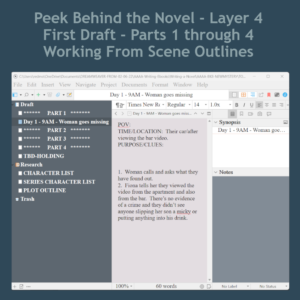 When I wrote my first novel, I worried about grammar, spelling, sentence structure in the first draft. I didn't even know what a draft was. I sat down and started writing 'a manuscript'.
When I wrote my first novel, I worried about grammar, spelling, sentence structure in the first draft. I didn't even know what a draft was. I sat down and started writing 'a manuscript'.
I kept looking back and trying to fix things as I wrote. Big mistake! I learned the long and hard way that first drafts are their own animal. They are really more about getting the story down on paper.
Now that I'm writing my 12th novel, I offer some tips for other beginners:
- Don't be afraid to make mistakes. Your first draft is not supposed to be perfect. It's only a rough draft. You're only 'blurting out the story' on paper. Spelling, grammar, punctuation or sentence structure don't count yet.
- Just keep writing. Don't stop to edit or revise in the first draft. It's a complete waste of time. You will make changes all throughout the draft, so polishing up writing that may be tossed is fruitless. You can fix the draft after you know you have the story down on paper.
- Don't worry about deepening the plot or the depth of your characters. Just focus on getting your story down on paper. You can massage the plot in second drafts and add to your characters on your second go-round.
- Write in a way that feels comfortable for you. Some people like to outline their stories before they start writing. Others like to just sit down and start writing without any planning. Find what works best for you and go with it.
- Set aside some time each day to write. Even if it's just for 30 minutes, make sure you set aside some time each day to write. This will help you to stay on track and to make progress on your story.
- Leave Notes to Yourself. Make notes to yourself wherever you stop writing in a session that will help you 'find your place' the next time you sit down. Write down what you're thinking and where your mind is at during this last writing session.
- Find a quiet place to write. Unless you are one of these lucky people who can shut out all noise and action around you, you will need to find a place where you won't be interrupted so that you can focus on your writing.
- Take breaks. Don't try to write for hours on end. Take breaks every 20-30 minutes to get up and move around, or to do something else that will help you to clear your head. It's even good to do some stretching exercises as sitting for long stretches can make us stiff!
- Don't get discouraged. If your story is a good one, there is no such thing as a bad draft. You're not the writer during the first draft. You are still the story crafter. So don't get discouraged if nothing seems like a novel. Like I said earlier, you are just blurting out the story, recording it in broad strokes onto paper. As you begin to work with the first draft, that's when it will come to life and shape up.
- Have fun! Writing should be enjoyable. If you're not having fun, it will show in your writing. So relax, have fun, and let your creativity flow.
I hope these tips help you to write a great first draft!
CHECK OUT MY PEEK BEHIND THE NOVEL VIDEO SERIES


 First there's the mystery outline of a novel. It's important to know where the mystery begins, the names of all suspects, everyone's motivation for murder or kidnapping, theft, etc. But once you have your crime and mystery outline, what then?
First there's the mystery outline of a novel. It's important to know where the mystery begins, the names of all suspects, everyone's motivation for murder or kidnapping, theft, etc. But once you have your crime and mystery outline, what then? The subplots should not detract from the main plot, but should instead enhance it. They should add depth and complexity to the story, and they should help to drive the main plot forward. In a mystery, it's easy to mirror a main character's personality trait in a witness and create some inner dialogue. This ties it in nicely.
The subplots should not detract from the main plot, but should instead enhance it. They should add depth and complexity to the story, and they should help to drive the main plot forward. In a mystery, it's easy to mirror a main character's personality trait in a witness and create some inner dialogue. This ties it in nicely.
 If you're writing a first-person novel, try using a different POV for your subplots. This can help to add variety to your story and to give readers a different perspective on the events. This is not a technique that I would suggest to beginner novelists, but for authors who are more seasoned, yes, this is a way to shake things up a bit.
If you're writing a first-person novel, try using a different POV for your subplots. This can help to add variety to your story and to give readers a different perspective on the events. This is not a technique that I would suggest to beginner novelists, but for authors who are more seasoned, yes, this is a way to shake things up a bit. Subplots can be used to ramp up the tension in your story. It's a great way to add a little more pressure onto your main character or characters! Not only do they have to catch the bad guy, but their landlord is threatening them, or their wife is threatening to leave them, etc. If the main mystery plot is getting a little slow as you drip in clues, you can spice up the subplot that will add some excitement and suspense.
Subplots can be used to ramp up the tension in your story. It's a great way to add a little more pressure onto your main character or characters! Not only do they have to catch the bad guy, but their landlord is threatening them, or their wife is threatening to leave them, etc. If the main mystery plot is getting a little slow as you drip in clues, you can spice up the subplot that will add some excitement and suspense. Subplots need to be interesting, yes, but it's easy to go overboard with them too. So the arc needs to be short but concise. They should be short and sweet, so to speak. They should be short enough to keep the reader's interest, but not so short that they feel underdeveloped.
Subplots need to be interesting, yes, but it's easy to go overboard with them too. So the arc needs to be short but concise. They should be short and sweet, so to speak. They should be short enough to keep the reader's interest, but not so short that they feel underdeveloped. I'm assuming all writers have doubts as they are writing the first draft. I know I do. Something happens between the feeling of knowing I have a good plotline and writing out the first draft.
I'm assuming all writers have doubts as they are writing the first draft. I know I do. Something happens between the feeling of knowing I have a good plotline and writing out the first draft. So the antidote to self-doubt is to keep writing. Trust your plotline. Know too that you can always add clues, rearrange some scenes, add a bit more intrigue into your subplots. Eight layers of writing leaves a lot of room for beefing up a story, deepening a story and polishing a story.
So the antidote to self-doubt is to keep writing. Trust your plotline. Know too that you can always add clues, rearrange some scenes, add a bit more intrigue into your subplots. Eight layers of writing leaves a lot of room for beefing up a story, deepening a story and polishing a story.


 Write forward only. Don't look back.
Write forward only. Don't look back.